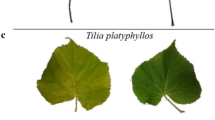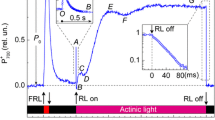Summary
The period of the rhythm of carbon dioxide output from leaves of Bryophyllum fedtschenkoi R. Hamet et Perrier at 15°C was shorter in continuous white light than in darkness. The period was monitored in leaves exposed to narrow spectral bands of monochromatic radiation at an incident quantum flux density of 4.7×10-11 einsteins cm-2s-1. Bands centred on 660, 600, 730 and 530 nm significantly shortened the period, the greatest effect being achieved at 660 nm and the smallest at 530 nm; those centred on 760 and 450 nm were without effect. None of the bands tested significantly lengthened the period. The period of the rhythm in leaves exposed continuously to monochromatic radiation at 660 nm decreased with increasing quantum flux density. The extent to which a quantum flux density of 4.7×10-11 einsteins cm-2s-1 at wavelength 660 nm shortened the period depended on the ambient temperature. At 15°C a significant reduction of 4.4 h occurred as compared with the dark control, while at 30°C no significant reduction was observed. The transient (the time from the initiation of the rhythm to the first peak) showed a greater dependence on temperature than did the steady-state period. No such difference could be detected in relation to the intensity or quality of irradiation. The reduction of the transient by the various irradiation treatments was, in general, proportional to the reduction of the period.
Similar content being viewed by others
References
Aschoff, J.: Exogenous and endogenous components in circadian rhythms. Cold Spr. Harb. Symp. quant. Biol. 25, 11–28 (1960)
Bollig, I.: Zusammenhang zwischen circadianer Rhythmik und Photoperiodismus bei Pharbitis nil Stamm “Violet”. Doctoral thesis Universität Tübingen 1974
Bünning, E., Moser, I.: Response-Kurven bei der circadianen Rhythmik von Phaseolus. Planta (Berl.) 69, 101–110 (1966)
Bünning, E., Moser, I.: Einfluß des Wassers auf die circadiane Rhythmik von Phaseolus. Naturwissenschaften 55, 450–451 (1968)
Bünsow, R.: Endogene Tagesrhythmik und Photoperiodismus bei Kalanchoë blossfeldiana. Planta (Berl.) 42, 220–252 (1953)
Halaban, R.: The circadian rhythm of leaf movement of Coleus blumeiixC. frederici, a short day plant. I. Under constant light conditions. Plant Physiol. 43, 1883–1886 (1968)
Halaban, R.: Effects of light quality on the circadian rhythm of leaf movement of a short-day-plant. Plant Physiol. 44, 973–977 (1969)
Hastings, J.W., Sweeney, B.M.: On the mechanism of temperature independence in a biological clock. Proc. Nat. Acad. Sci. 43, 804–811 (1957)
Hastings, J.W., Sweeney, B.M.: The Gonyaulax Clock. In: Photoperiodism and related phenomena in plants and animals, pp. 567–584. Withrow, R.B. (Ed.) Washington, D.C.: American Association for the Advancement of Science 1959
Hoffman, K.: Overt circadian frequencies and circadian rule. In: Circadian Clocks, pp. 87–94, Aschoff, J. (Ed.) Amsterdam: North-Holland Publishing Co. 1965
Jones, M.B.: Some observations on a circadian rhythm in carbon dioxide compensation in Bryophyllum fedtschenkoi. Ann. Bot. 37, 1027–1034 (1973)
Jones, M.B., Mansfield, T.A.: A circadian rhythm in the level of the carbon dioxide compensation point in Bryophyllum and Coffea. J. exp. Bot. 21, 159–163 (1970)
Jones, M.B., Mansfield, T.A.: A circadian rhythm in the level of carbon dioxide compensation in Bryophyllum fedtschenkoi with zero values during the transient. Planta (Berl.) 103, 134–146 (1972)
Kleinhoonte, A.: Untersuchungen über die autonomen Bewegungen der Primärblätter von Canavalia ensiformis DC. Jb. Wiss. Bot. 75, 679–725 (1932)
Lörcher, L.: Die Wirkung verschiedener Lichtqualitäten auf die endogene Tagesrhythmik von Phaseolus. Z. Botan. 46, 209–241 (1958)
Wilkins, M.B.: An endogenous rhythm in the rate of CO2 output of Bryophyllum. II. The effect of light and darkness on the phase and period of the rhythm. J. exp. Bot. 11, 269–288 (1960)
Wilkins, M.B.: An endogenous rhythm in the rate of CO2 output of Bryophyllum. III. The effects of temperature on the phase and period of the rhythm. Proc. R. Soc. B 156, 220–241 (1962)
Wilkins, M.B.: An endogeneous rhythm in the rate of CO2 output of Bryophyllum. VI. Action spectrum for the induction of phase shifts by visible radiation. J. exp. Bot. 24, 488–496 (1973)
Author information
Authors and Affiliations
Rights and permissions
About this article
Cite this article
Harris, P.J.C., Wilkins, M.B. Light-induced changes in the period of the circadian rhythm of carbon dioxide output in Bryophyllum leaves. Planta 129, 253–258 (1976). https://doi.org/10.1007/BF00398267
Received:
Accepted:
Issue Date:
DOI: https://doi.org/10.1007/BF00398267




